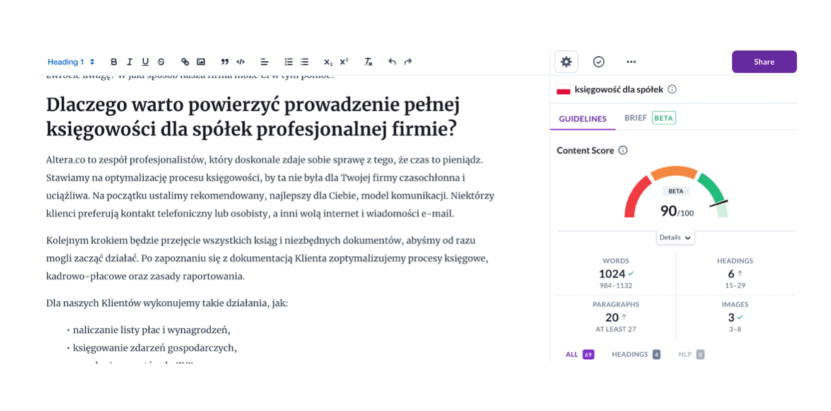Saturation of phrases and good content: how to do it with your head?
The concept of valuable content that can work for the client requires a wide, comprehensive approach in many respects. What elements are worth paying special attention to? How to make your work easier?
When the next trading Sunday? Will the next commercial Sunday be in two weeks? And when is the next commercial Sunday on vacation? And why is there so few commercial Sundays in 2021? And what about elections in 2023? When elections in 2023 in Poland? What parties will start in the elections in 2023?
These are just two examples that show that the topic of phrase saturation is an issue that many people still cause problems, and readers can discourage reading the whole text. Let’s see what to do to avoid such situations. Let’s start with what the key phrases are for and what they are.
Writing content on the internet is still changing
In recent years, the creation of valuable publications has evolved very much. Currently, to create an entry that even if you have a chance for high places in the Google search engine, it is not enough to write an article exhausting the topic. Apart from a few exceptions, where specialist industries can be mentioned, for example, the appropriate text design plays an equally important role.
The right paragraphs, alternative graphics descriptions, as well as the structure of the page are also of great importance. Even the best content will not defend itself if the website does not apply to the Mobile First rule or is on the black Google list.
This shows that to create publications on the web must be approached in a concrete, comprehensive manner. Even if we employ the best copywriter, the site will not use all its potential without proper technical facilities.
Content without phrases does not exist?
Content that is created in such a way as to ensure a lot of traffic must be based on key words and phrases. It is here that specialists from SEO and content departments often meet with each other. The former should provide appropriate phrases, and people working with the text must entwine them into the planned publication.
There are also changes here too. Google robots have been able to effectively catch and ignore publications for at least a few years, which are based only on the saturation of the text with phrases, which in no logical way are not related to it.
Algorithms can assess such publication in a critical manner. The new Bert algorithm that uses NLP technology played a big role here. This means that since 2020, the search engine giant has been able to analyze, among others, the differences in phrases.
How to properly manage phrases and dependent words in the text?
First of all, we should look at such a text as a coherent whole. Despite the fact that subsequent algorithms are increasingly affecting work with a publication, it is worth remembering that the text is also attractive to the recipient. Just such high -quality publications that will not look like they were created in the first better generator, we create in Takoto.
The phrases should be placed in the text in the right way. Let’s assume that we position a client who works in the fire hoses industry. It is also our keyword. It is good practice to place the customer name next to the main phrase or – or – one of the auxiliary phrases. This is especially important when we want to link a page with a link, whose anchor is the name of the brand. We write more about this on the site MarketingProgress.pl.
Usually, you can easily carry out such a procedure. Just use the services of the appropriate copywriter. Let’s also remember that the era of bolding all the keignords has long been a thing of the past. This is practically no matter for the Google algorithm, and it effectively irritates the recipient.
If we create a longer publication, it is worth skillfully spreading the phrases and words selected by the SEO department. If we use them all in one paragraph, it is very likely that it will look unnatural, which can catch the algorithm. It is much better to manage phrases in such a way that these are spread as much as possible, after the entire publication.
Let’s also remember that a good phrase is a changed phrase. Once again, citing, for example, fire snakes, let’s not be afraid to change these words. Just like others that the copywriter got in the content plan for a given publication.
Useful tools for phrase management in the text
The longer the text and the greater the number of words and phrases, the greater the chance that we will not be able to control them on their own. Fortunately, you can make your job easier, using, for example, Editor content, which is included in Surgerseo.
The tool will allow us to manage the text in an extremely simple way, and also tell us if the density of keywords is sufficient. This is one of the basic applications that all professional copywriters should have on their list.

Of course, the most important role here is the counter (content score), where on a scale of 1 to 100 we will quickly assess whether the text fulfills the main goals set before it. When the publication gains a grade not lower than 80/100, it can be said that the saturation of the phrases and its design is satisfactory.
Content score analyzes the main variables, including:
– number of words,
– the number of headers,
– number of paragraphs,
– number of graphics.
The tool also shows the location of selected words or phrases in the text, thanks to which you can quickly estimate whether there is too much (or too small) saturation in the selected paragraphs.
Is there a universal method to calculate the proper saturation of the phrases?
It is good practice to use at least one auxiliary phrase for each thousand characters with a space. So, in a text with a length of 6K ZZS, we should use about twelve auxiliary phrases, of which the text should be not less than ten. By controlling the density of phrases, our publication will not look like spam.
Once again, it is worth reminding you to pay a lot of attention to language correctness. The phrase may – and even should – be changed if it is required to ensure adequate comfort for the final recipient. In the opposite situation, we can suddenly wake up with a publication, where in the header and the first two paragraphs there will be sentences like from the legendary text about commercial Sundays or parliamentary elections.
